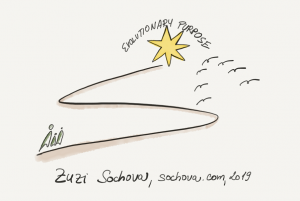Companies are not scaling Agile or Scrum, they are scaling success. At our agile journey, we were often wondering how to start, what practices, tools, and processes shall we use. What I learned on my journey is that we don’t need another method. None of these are silver bullets anyway. They are all great for the beginning to change the way you work and to change the mindset. But the most important part of your journey is success. Can you share a success story? Using your own language, describing how your own environment changed, showing the impact the different ways of working created? If yes, people start picking up and trying to achieve a similar impact. The most successful agile transformations I’ve seen started exactly like it. With a small team experimenting with practices, and sharing the impact with others and depending on the starting point, sharing the various different success stories, i.e. 5 times less bugs reported by customers, 3 times more value delivered by the given time (which is not the same as more functionality but quite the opposite), significantly faster time to market, higher motivation and engagement score, more innovations which result in higher customer satisfaction, … the impact varies depending on the environment. For us a few years back it was higher flexibility, faster learning, and higher customer satisfaction.
Sharing success is not anything new in change management. It’s one of the Eight steps for successful change by John Kotter which for some reason are still not widely known in an agile community, so I thought I remind you about them here:
- Create a sense of urgency – Unless you know why you are changing the way you work (to be more agile, Scrum, or Kanban), then don’t do it. Neither Agile, Scrum, or Kanban is your goal. They are just ‘walking sticks’ helping you on your journey to success. You need to have a higher purpose defined which will be stronger than their individual goals and therefore unify people.
- Build a guiding coalition – You can never change the organization alone. You need to find supporters (agile enthusiasts in this case) who will create a team that will help you change the system. So, at the minimum two additional people who are true agile believers, as three are the smallest team possible. The rest will join you in seeing the results.
- Form a strategic vision & initiatives – Sometimes having a purpose is not enough as people don’t see a way how to get there and the whole change is too abstract. That’s a space where frameworks, methods, and practices are useful.
- Enlist a volunteer army – Finally, it’s a time to make it bigger. Make it a movement, not just another project. Get buy-in from larger crowds. Get them involved. Again, if you skip some of the previous steps, there is no way it’s going to scale.
- Enable action by removing barriers – Now, once you have the energy by your side, you need to help it and remove barriers (hierarchy, silos, detailed positions, individual KPIs, … ), otherwise, all the initial enthusiasm is gone before you realize it.
- Generate short-term wins – Show the success early and often, make it visible to everyone. Share stories talk about improvements, celebrate even small steps. Success is a strong engine for change. Accelerate, multiply success. Without it, any change will die.
- Sustain acceleration – You can celebrate, but you can’t stop pushing after the first win, being too satisfied with your progress. There is always a better way. Find another challenge, discover a better way of working until the vision of the new way of working defined by the original purpose becomes true.
- Institute change – Finally by creating connections between the new way of working and success you keep the change stick. It’s the final glue that prevents the environment from flowing back to the old way of working again.
Agile is a change, and without driving it as a change you can hardly be successful. So don’t forget the define how success looks like, celebrate it, and make it better over time.

